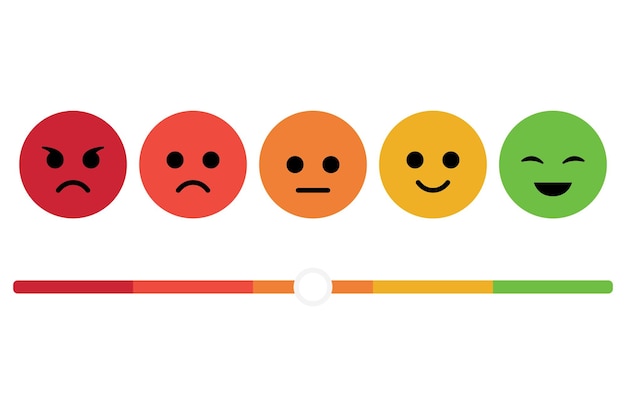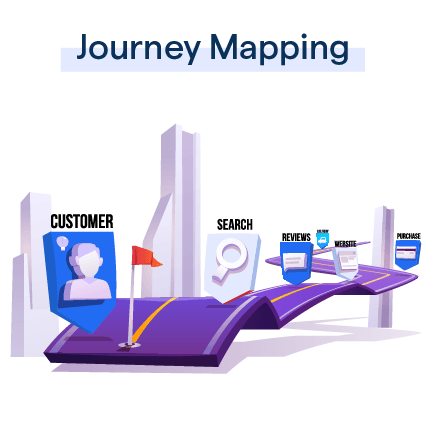What is Journey Mapping?
Journey mapping is the process of visualizing and documenting the various touchpoints and interactions a customer experiences while engaging with your product, service, or brand.
The primary goal of journey mapping is to uncover pain points and areas of improvement in the customer journey, thereby fine-tuning the experience to meet customer expectations.
Journey mapping allows businesses to empathize with customers by analyzing their experience from the customer's perspective, thus enabling companies to make more informed decisions based on genuine insight.
Enhancing Customer Experience

Developing a comprehensive journey map helps businesses identify crucial touchpoints and interactions, ensuring a seamless and memorable experience, leading to higher customer satisfaction and loyalty.
Streamlining Internal Processes
By identifying potential bottlenecks and inefficiencies within the customer journey, businesses can optimize their internal processes, boosting overall productivity and reducing operational costs.
Stay Ahead of the Competition
In an era where customer experience is a key differentiating factor, journey mapping provides businesses with the insights needed to surpass the competition by maintaining an outstanding customer experience.
With a well-executed journey map, companies can optimize the customer experience, helping them retain loyal customers and achieve long-term success based on superior insight and informed decision-making.
Key Components of a Journey Map
In this segment, we'll outline the vital components that make up a comprehensive customer journey map, offering a more precise and rich insight into your customers' experiences.
Personas
Personas are fictional representations of your customer segments. They are crafted from research and insights and demonstrate diverse customer behaviours, motivations, goals, and challenges. They serve as anchors to humanize your journey map.
Stages
These delineate the different phases a customer goes through when interacting with your business. They often include stages like awareness, consideration, purchase, use, and loyalty. These stages help you capture and understand the progression of the customer journey.
Touchpoints
Touchpoints represent every point of interaction your customers have with your brand across multiple channels. Understanding and mapping these touchpoints onto your journey map can help you identify opportunities for improving customer experience.
Customer Emotions

Customer journey maps should not just be transactional but should also capture the emotional experience. Mapping out how customers feel at different stages and touchpoints can provide critical insights into where and how to enhance their experiences.
Opportunities for Improvement
This component involves identifying pain points, bottlenecks, and areas of friction in the customer experience. These areas represent opportunities for improvement and should guide decisions about where to invest resources to optimize the customer journey.
Journey Map Variations
In this section, we'll delve into the various types of customer journey maps that businesses can utilize to understand and enhance the customer journey.
Current State Journey Maps
These maps depict the actual existing journey a customer goes through while interacting with your business. They provide real-world insights, highlighting areas where you meet or fall short of customer expectations.
Future State Journey Maps
These are aspirational maps visualizing an optimized journey that your business aims to provide to its customers. They serve as a blueprint illustrating the ideal experiences you wish to offer.
Service Blueprint
This is a deeper version of a journey map that not only includes the customer’s journey but also the processes happening behind the scenes impacting the user experience.
Day-in-the-life Maps
These maps outline a typical day of a user, irrespective of their interaction with your business. These maps help understand broader user context and lifestyle.
Ecosystem Maps
These maps broaden the scope by exploring how the user interacts with the wider ecosystem, encompassing not just your product but competitors, influencers, and other external factors.
Experience Maps
An experience map goes beyond a single product or service, capturing all the points of interaction a user has with your business’s brand across all channels, locations, and touchpoints.
Benefits of Journey Maps
In this section, we'll delve into the significant benefits of employing customer journey maps into your business practices, highlighting how they can bolster your understanding and optimization of the customer experience.
Enhances Customer Understanding
Journey mapping allows you to see your business through your customers' eyes. It provides detailed insights into customer needs, expectations, and experiences, thereby enhancing your understanding for customer.
Identifies Pain Points
By mapping out the customer journey, you can identify areas where customers encounter challenges or discomfort. Addressing these pain points can substantially improve customer experience and satisfaction.
Helps Personalize Experience
Understanding the customer journey assists in personalizing the customer experience. By tailoring interaction based on customer behavior and preferences, companies can create customized experiences, enhancing customer loyalty and retention.
Boosts Cross-Functional Collaboration
Customer journey maps provide a shared vision and understanding across the organization, promoting cross-functional collaboration. They help break silos and foster a collective focus on customer-centricity.
Guides Strategic Decision-making
Journey maps aid strategic decision-making by identifying where to invest resources for greatest impact. They help prioritize actions that will significantly improve customer experiences, thereby driving business performance.
Measures Customer Experience
Journey maps can serve as an effective tool to measure and track customer experience over time. By comparing past and present journey maps, businesses can gauge the effectiveness of their customer experience strategies.
When to Create Customer Journey Maps?
In this section, we'll explore the optimal times to develop customer journey maps to enhance customer experience and service delivery.
Initial Product or Service Launch
When launching a new product or service, a journey map can help you understand how your target customers will interact with your offering.
Periodical Strategy Revisions
Businesses evolve and so do their strategies. During these revisions, it's crucial to reassess customer journeys to ensure alignment with the new strategic direction.
Customer Feedback Analysis

When receiving substantial customer feedback, journey mapping can help identify root causes of issues, pains or delights experienced throughout their interaction with your business.
Pre-empting Market Shifts
As markets evolve, so do customer behavior and needs. Keeping updated journey maps allows businesses to anticipate changes and proactively adjust their strategies.
Service Improvement
If you notice a drop in customer satisfaction scores or an increase in complaints, it's time to relook the customer journey and identify areas for improvement.
Expansion into New Markets
If you're planning to tap into new markets, understanding and mapping the customer journey specific to that market is crucial for ensuring effective communication and services.
The 5-Step Process of Journey Mapping
In this section, we'll dive into the five key steps involved in journey mapping, helping to ensure your business effectively understands, serves, and enhances the customer experience.
Step 1
Understand the Customer
Start by collecting quantitative and qualitative data on your customers. Deploy methods like surveys, user feedback, or customer interaction analytics. Formulate key personas to represent your diverse customer segments accurately.
Step 2
Identify Touchpoints
Your customers interact with your business via various touchpoints—website, social media, customer support, or physical stores. Identify these touchpoints and understand how customers move and interact across these various platforms.
Step 3
Map the Customer Journey
Now, with your personas and touchpoints, map out the customer journey. Visualize how different personas navigate your business from the initial awareness stage through to a purchase and beyond. Highlight the interaction points, emotions, and decisions at each stage.
Step 4
Analyze the Map
Once the map is in place, it's time to analyze. Identify hurdles, delight moments, and areas of friction. Look for patterns and trends among different personas. This step will help you spot opportunities for optimization and enhancement.
Step 5
Implement Improvements
The ultimate goal of journey mapping is to enhance customer experience. Use your analysis to implement changes, test outcomes, and iterate on methods to constantly improve the journey and, in turn, customer satisfaction and loyalty.
Frequently Asked Questions (FAQs)

Why is journey mapping important in UX design?
Journey mapping is important in UX design because it helps us understand the user's experience, identify pain points, and create more satisfying interactions.
How can journey mapping benefit my team's collaboration?
Journey mapping fosters collaboration by providing a shared vision, aligning team members towards a common goal, and facilitating communication about user experience improvements.
What are the key components of a journey map?
The key components of a journey map include the actor (representing the user), scenarios, journey phases, actions, mindsets, emotions, and opportunities for improvement.
What are the differences between journey maps and other mapping techniques?
Journey maps focus on user experience, while experience maps provide a broader view. Service blueprints focus on the business perspective, and user story maps prioritize product functionality.
When should I create a journey map?
Create a journey map when launching a new product, introducing updates, experiencing customer churn, or seeking to understand different user segments' experiences.

